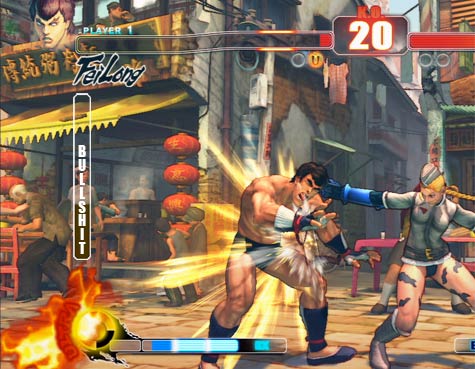Matthew Wasteland’s writing is always worth a read, and I really enjoyed The Madeleine in Eight Bits recently. One quotation from the comments thread, though, got me thinking:
That was an interesting article. I was playing the indie game “Don’t Look Back” today and although I enjoyed it couldn’t help but wonder if it really needed to be so blocky. If it couldn’t have expressed it’s themes without the old school affectations.
This coincided with reading Leigh Alexander’s Video Game Hipsters, considering the convergence of “indie” and “lofi” viewed through a lens of cultural knowing.
And this all got me thinking about the lo-fi aesthetic, and “programmer graphics”, and “ugly” games.
Because, to respond to the commenter on Magical Wasteland, I’m not sure how “old school” its affectations are. Yes, it has a retro look-and-feel, and a simple mechanic (not to mention an old-school difficulty curve). But there’s something about it that’s incredibly next-gen to me: it was made by one programmer.
Now, of course, once upon a time, all games were made by one programmer; there’s nothing new about bedroom pgoramming. But what’s truly modern is the distribution: that one game, made by one programmer, already has a huge potential audience; it plays on any browser, and can be played anywhere in the world, at any time.
“Next-gen”, for me, exists at two ends of a spectrum. At one end of the scale, it is 1080p at 60fps, complex shaders and normal mapping, realistic cities, licensed soundtracks, multi-million dollar marketing budgets.
And at the other end, next-gen is empowerment. Making games is easier than ever before. And not just the programming part – the “making games on your own computer” part of the equation. I mean making games that other people can play. Flash is a wonderful tool, readily available (because let’s face it, how many Flash developers have – or at least, start out with – a legal copy of Flash CS4?), powerful, and it’ll work a) on anything and b) anywhere. The barrier to entry is lowered by better tools, higher level languages, and more powerful clients that mean you don’t have to optimise so much; but the real magic is that Kongregate and similar portals have lowered the barrier to distribution.
I think that the reason it appears blocky and crude is so that it could be in the world.
Matt‘s T-shirt stands as a point of reference: “Get excited and make things“. And: make things that are in the world. Applications I can use, t-shirts I can wear, games I can play. If you’re no good at graphics, maybe a pixellated look is all you’ve got time for – but is that enough to make your point? Because if it is, get that game into the world, watch the feedback, make another. Don’t bog down the ideas with asset workflows.
Right now, the predominant aesthetic in indie isn’t just a memory-saving exercise, or a nostalgic tip of the hat to the games we learned from. Yes, it is definitely both of those things, but to my mind, it’s more important that it’s a way of lowering the barrier of getting ideas into the world. Because until it’s a game I can play, it’s nothing.
The most significant change is not the better tools, it’s the better distribution. Compare XNA to the Net Yaroze. The idea of a home console you – as a consumer at home with appropriate skills – could actually make “real” games on was remarkable, at least to me. But what about a console where not you can not only make “real” games, but also sell them, and distribute them to every living room in the world? That’s what XNA Community Games is offering.
That, right there, is your “next-gen”. That’s a service crying out for games to be built for it, so they can be played by anyone. And if that means we take a hit on the art, then so be it. Ugly games may not be great sellers, or to everyone’s tastes, but they are a great way to get more games into the world. And who knows: some of those games might not be pixellated, 8-bit throwbacks. The more you do something, the better you get at it; a year of low-fidelity, two-week games, might make that blockbuster a year later. Look at how Blurst prototype. Look at Gregory Weir’s game-a-month. Even if the games they’re making are not always great shakes, the experience they’re gaining by practicing their craft in such a condensed, rigorous, and demanding manner is far better than a year spent making brick textures for a game that will never, ever, be fun.
The way games get better is if there are more of them, and I’ll do anything to ensure we get more games in the world, that programmers, designers, and artists can make more games, not fewer. If that means resorting to “old-school affectations”, or “programmer graphics”, or any other synonym for ugly: so be it. Yes, the “retro” aesthetic is, I’m sure, as much a trend and aesthetic decision as it is a conscious choice – but it’s not just videogame hipsterism; it’s a pragmatic choice made by those not just interested in making things, but making real things.
More games in the world. And, over time, one would hope: more good games; more important games; more significant games; more remarkable games. Not all of them will ugly, but they’ll be better for the more games that have gone before them. And so, to Terry Cavanagh, and all those like him, I say: keep going.
You keep going, and I’ll keep playing, whatever your games look like.
